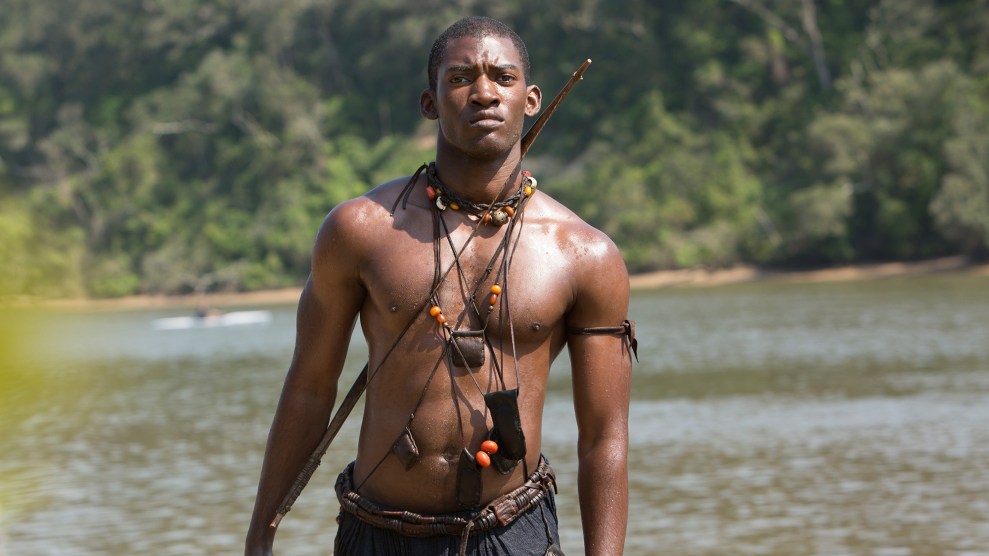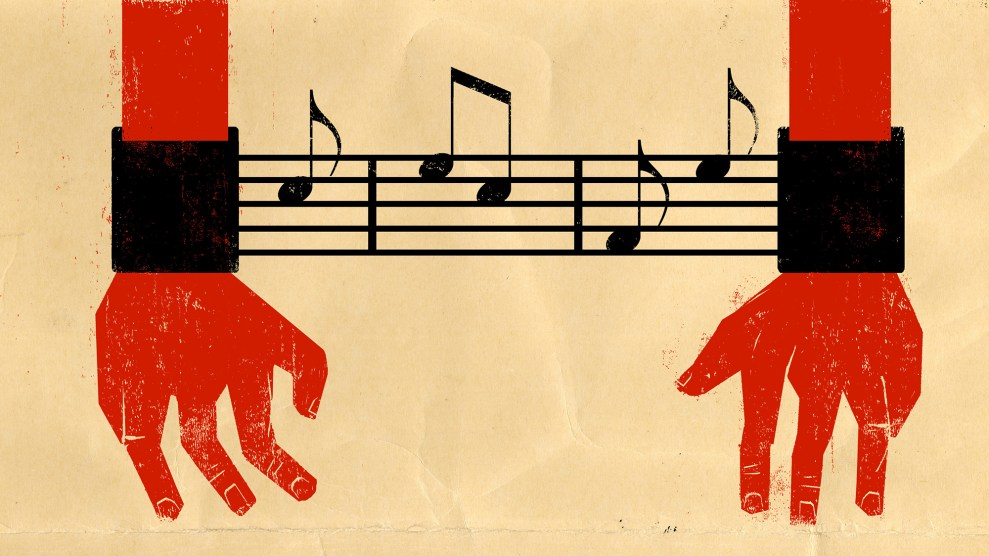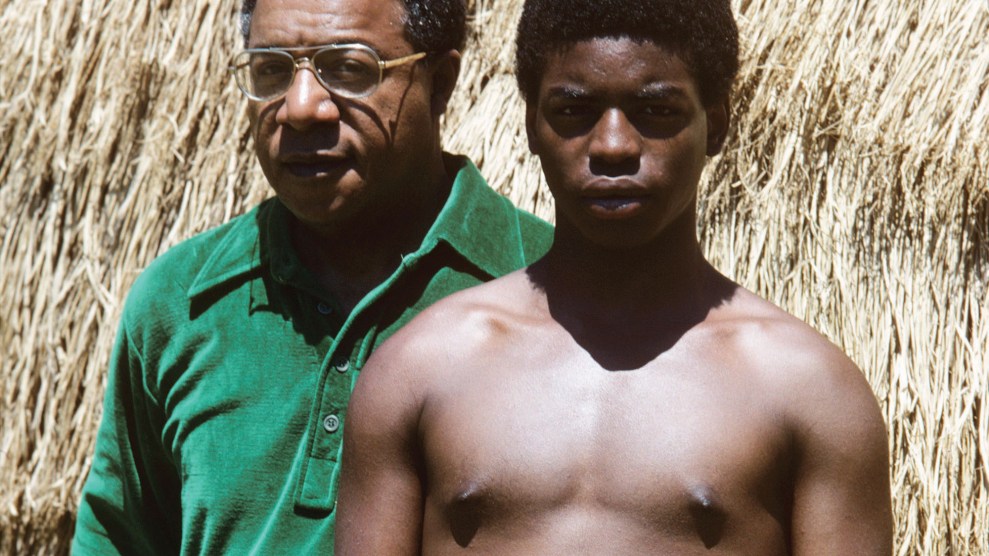
The British actor Malachi Kirby as Kunta Kinte.Casey Crafford
What are the most-watched shows on television these days? I checked. For network TV, as of the end of March, Nielsen listed The Big Bang Theory, with 14.2 million viewers, followed by Empire, with 12.5 million. (Empire led among black viewers.) For regular cable, The Walking Dead dominated with 14 million viewers. In the premium realm, in April, the season premiere of HBO’s popular Game of Thrones drew roughly 8 million viewers.
Compare that with Roots, the eight-part miniseries based on Alex Haley’s fictionalized family history, which first aired on ABC in January 1977. America’s population was just 220 million then—it’s 323 million now—and nearly 29 million households watched Roots that first night. By the finale, more than 36 million households (100 million-plus individuals) were tuned in. It was the most-watched miniseries in history, beating out the previous year’s Gone With the Wind saga, which depicted a romantic version of slavery.
In his upcoming book, Making Roots: A Nation Captivated, Arizona State University historian Matthew Delmont recalls how the original book and series took flack for historical inaccuracies, and how Haley himself was attacked for plagiarizing passages and for playing loose with the facts. But simply depicting the horrors of slavery onscreen was revolutionary. Delmont quotes a Washington Post reviewer: “The scenes on the ship, with the slaves chained together, stacked alongside one another, lying in their vomit and excrement…are something we have never seen before. We have read about slavery. But we have never seen it, never in such painstaking detail and never being experienced with such excruciating pain.”
As you’ve likely heard, Roots is back, re-envisioned for a 2016 audience and airing for four straight nights on History starting last night. (You can watch it here.) And who better to watch it with than Delmont? What follows is the first of our four conversations recapping each installment as it airs. And yes, there will be spoilers.
Michael Mechanic: I’m old enough to have seen Roots when it first came out, and I can remember how big a deal it was. Everyone I knew was watching it. I was 11, growing up in a white, middle-class neighborhood in Wisconsin, and it had a big impression on me. Matt, you’re younger than me and African American. How did you come to see the original series—let alone write a book about it?
Matthew Delmont: I was born just after Roots aired in 1977, so my first memory is watching part of it in school when I was 10 or 11. I don’t remember much about the first time, other than the scene where Kunta Kinte is whipped until he accepts his slave name, Toby. I became interested in Roots a few years ago because I’m a historian, and my research focuses on African American history and television history. I was surprised to learn that, while there are a few good articles and chapters, no one had written a book about Roots. As it turns out, there are great archival sources: Alex Haley’s papers are at the Schomburg Center for Research in Black Culture in Harlem, the University of Tennessee, and Goodwin College in Hartford. And the University of Southern California has the papers of television producers David Wolper and Stan Margulies, who brought Roots to ABC. So I’ve rewatched and reread Roots a few times over the past couple of years.
MM: That whipping scene is etched in everyone’s memories, I think.
MD: It was just as powerful in the new Roots as it was in the original. I knew what was going to happen, but I still teared up. What stood out were the reaction shots of other people watching Kunta being whipped—both the enslaved characters and the plantation family.
MM: Yeah, I mean, you have Fiddler, Forest Whitaker‘s character, quietly begging Kunta to say “Toby” and end the punishment. What read did you get from the slave owners?
MD: From Fiddler and the other enslaved characters, you get the sense that this type of violence was commonplace on the plantation, but still horrific. Also, they have the scene take place on Christmas day, which makes it even more troubling. From the owners, seeing Mrs. Waller (Katie McGuinness) shudder was interesting. She had given Kunta the name, and now she is watching the overseer beat him into accepting it. The scene also made me think of how much more explicitly violent television is today than it was in 1977. I don’t think this scene is more gory than Game of Thrones, but the stakes felt higher to me.
MM: I noticed that too, back on the slave ship. In fact, let’s step back to Kunta Kinte’s village in Africa. The origin story is a bit different this time around. These Mandinka tribesmen are Muslim horse warriors. And part of the new story line involves blacks enslaving blacks.
MD: The Kinte family in the original book and series are Muslim, but the politics around this faith/identity today are more controversial now than in 1977.
MM: They played it up in the new version more than I recall in the old one.
MD: That’s funny, I thought the references to Kunta’s faith were sort of understated.
MM: Okay, well, as a kid watching the original, I was probably oblivious. What else did you notice?
MD: The Africans enslaving Africans is an important difference. In the original version, there were blacks who helped the European slave catchers, but here it was presented more as part of conflict among tribes within the Gambia (and other parts of Africa) that led to the capture and sale of slaves. I’m not sure what I think about this. This representation is more historically accurate, but the “blacks capturing blacks” is one of the points people fall back to when they want to make it seem like slavery wasn’t that bad.
MM: I see how that would evoke complicated feelings. I guess people have been enslaving each other forever, and this shares the blame around a bit. But the European slave trade seems different because of the vastness of the business and the fact that you’re taking people far from their homelands.
MD: Yes, and the fact that, in the New World, slavery became a hereditary condition that could be passed down from mother to child.

MM: Let’s dwell on that a second. When one tribe enslaved someone from another tribe, what was the fate of that slave?
MD: That’s not my area of expertise, but from what I understand, people who were enslaved in those circumstances were held for a period of time. The series seems to reference that when Kunta arrives at the plantation and asks for how long he will be held as a slave. The idea that you would be a slave for your whole life, and your children would also be slaves, was new.
MM: Also, when Kunta is on the wagon pulling into the plantation for the first time, and he sees the slaves in the fields, and he says, “So many!” The scale of it is a shock to him.
MD: The scale and economics of slavery were massive on many plantations. I think the first episode does a nice job of pointing to some of these issues while still trying to maintain the narrative.
MM: You’ll recall that in the original, as LeVar Burton emphasized in an interview with Mother Jones, they cast “all of America’s TV dads as villains”—Ed Asner as the slave ship captain, and so on. Who did you like in the new cast?
MD: Forest Whitaker really stood out. I also thought Malachi Kirby, whom I don’t think I’ve seen in anything before, was very compelling at Kunta Kinte. So much of the story turns on whether viewers take to Kunta, and I think he really pulled that off. I was struck by how few white stars were in the first episode. One of the reasons they had Ed Asner show up eight minutes into the original was because the producers were worried white viewers would tune out if they didn’t see recognizable white actors. From that perspective, I thought the casting and pacing of the first hour was really interesting.
MM: I hadn’t thought of that. Let me ask you this: I’ve heard from some black friends that their parents basically sat them down at some point and made them watch Roots. But I don’t know of many white parents who did that, even though this is our common history. I was actually thinking about my 11-year-old daughter and, you know, just not wanting her to experience this horrible stuff. At the same time, I want her to—at least at some point—get a sense of slavery that the schoolbooks don’t deliver.
MD: I don’t know what the right age to watch this is, but one of the things Roots can do is ask viewers to see slavery as a history of thousands of individual people and families. Slavery still isn’t taught very well is schools, and Americans generally prefer not to talk about it too much. When we do discuss it, it is easy to view enslaved people as an undifferentiated mass of people, but we lose sight that these were people and that these people were daughters and sons, mothers and fathers. While Roots is fictionalized, it does help to humanize the history of slavery in powerful ways.
MM: The new Roots can’t hope to match the viewership of the old one. How big a deal do you think round two will be?
MD: Yeah, only the Super Bowl gets the kind of audience share Roots got in 1977, so the benchmark will have to be different. The new series is well timed. Underground did better than most people expected, and the history of slavery is being talked about more than it has been for a generation. Roots also has an important legacy in TV history, so I think the new series will generate interest for that reason. The shows people write and talk about today (Mad Men, Breaking Bad, Game of Thrones) don’t actually have huge numbers of viewers. I’ll be interested to see if Roots can get critical attention in this new media environment.
MM: Oh, every columnist is going to write about it! But back to episode 1: How would you compare the watchability of the old versus the new? I thought this flowed fairly well, but then there were moments that felt abbreviated—like some slaves being sold off literally as soon as Kunta sets foot on the plantation. It felt a little heavy-handed, like, “We only have four episodes, so we’ve got to stuff everything in.”
MD: The production values of the new series (lighting, sets, etc.) make it more watchable than the original. I also felt this sort of time crunch, where they took the first two episodes from the original series and squeezed it into one. Like there was that random scene where an enslaved woman tells Kunta, out of the blue, that he can have her if he wants her. We have no idea who she is, or if she’ll show up in episode 2!
MM: I was flummoxed by her, too. Like, “Whoa! That’s pretty forward there, lady!”
MD: Roots, the book and series, had a problem with gender because Alex Haley was really only interested in advancing the narrative from Kunta in the 1700s to Haley’s birth in the 1900s. So the female characters in the book are really underdrawn. The 1977 series did a bit better, because they had strong actresses like Leslie Uggams, Madge Sinclair and Cicely Tyson, but the first episode makes me worried for how women will (or will not) feature.
MM: Kunta’s daughter Kizzy should be along soon enough. That’s a strong part.
MD: Yes, we should see Belle in episode 2 and Kizzy in 2 or 3, I guess. A big challenge the producers face is trying to tell this multigenerational story in a way that’s interesting to audiences. I mean, Roots is going to cover dozens of characters over a century, whereas something like Underground can have the same characters develop over a series of weeks or months.
MM: Good point. In the original, I recall Kunta suddenly becoming this old guy.
MD: The great jump cut from LeVar Burton to John Amos!
MM: What else did you like or dislike about episode 1?
MD: I liked the small gestures: Kunta holding another man’s hand on the slave ship as they start to plot the revolt. I liked how the revolt was filmed. Again, I knew what was coming. I knew they weren’t going to be able to take over the ship. But I was still rooting for them, and I was moved by the filming of it. And then the song Kunta shares with Fiddler was nicely done.
MM: Isn’t it funny how we can get wrapped up in a battle knowing that our hero is going to lose?
MD: It speaks to the power of the story. Even more broadly, we know Kunta isn’t going to die, but we still worry for his safety on the boat and later. Getting viewers to identify with an enslaved character in that way is really powerful.
MM: Not just with Kunta, but with the plantation slaves, like Fiddler, who has worked so hard to ingratiate himself with the master, swallowing his dignity, and then he gets screwed over anyway. That stuff just tears at you, the petty cruelties.
MD: And that one of the first things that happens when Kunta arrives at the Waller plantation is that Samson is sold away to Georgia—that years of “good” service don’t count for anything, and families could be broken up at any time. Those are the sort of details I don’t think most people think about in relationship to slavery.

MM: Meanwhile, the owners are just so wrapped up in their own little dramas that they could give a shit. I find the white characters interesting in that they try to justify these things to themselves.
MD: It’s hard to come away from that first episode and think that there is any such thing as a “good” slave owner. The overseer may be the one to inflict the punishment, but all members of the plantation family are implicated. It will be interesting to see what they do with the different white characters. There was a white indentured servant who participated in the escape at the end of the first series. It is so common for Hollywood films and TV shows to have white savior characters swoop in to save the day. I hope they avoid this trope.
MM: Resist, Hollywood! Resist!
MD: If you read Haley’s book, the white characters have no interiority at all. There isn’t even a white character with a proper name until chapter 50. They are all just called toubob.
MM: That’s super interesting. Okay, we shouldn’t go too long, here, but was there anything that annoyed you about Night 1?
MD: Only the woman who randomly offered herself to Kunta. I’m also not sure why the circumcision scene needed to stay in this new version, and that it seemed to be followed by a very brief masturbation scene in the water.
MM: Oh my god! I didn’t even get that! I thought they were just nursing their painful post-circumcision schlongs in the cool water. You think they were masturbating?
MD: I don’t know. The look on Kunta’s face does look like pain. Maybe I’m reading too much into it.
MM: Well, in the book, which I read as a kid, isn’t he married and has sex before he’s enslaved?
MD: No. Actually one of the weird things is that Kunta is a virgin until he is married in his late 30s. There are a couple of wet dream scenes in the book, which is why I thought maybe they were hinting at something in the new series. But I didn’t mean to take up this much space talking about masturbation!
MM: Oh, there’s always space in our pages for masturbation. This is the internet, after all.
Click here for Michael Mechanic’s and Matthew Delmont’s discussion of episode 2.
















